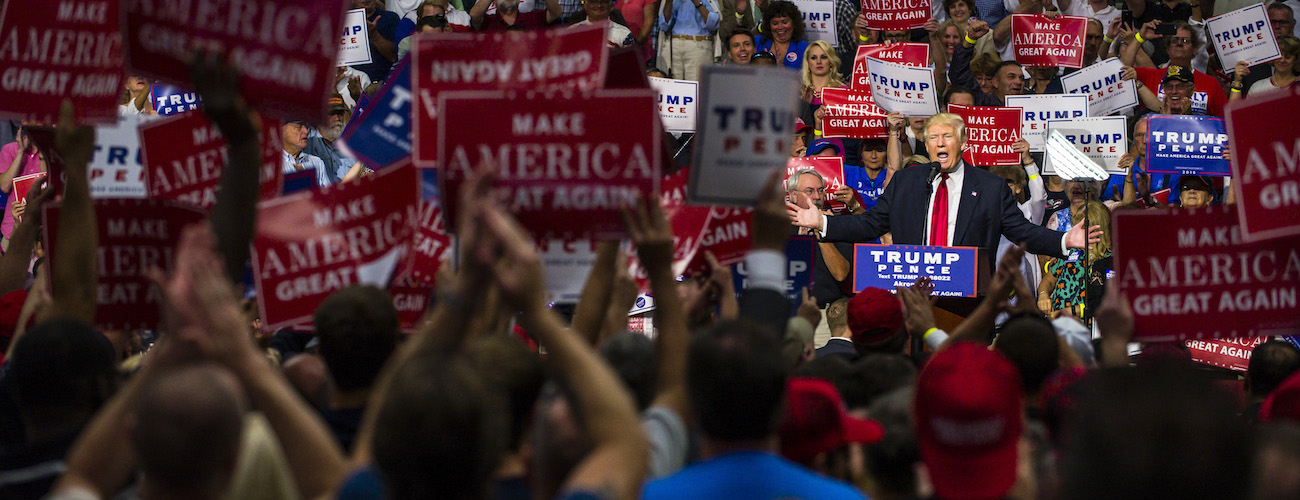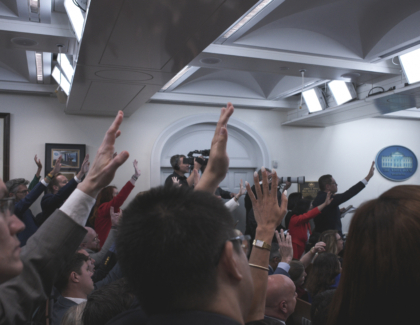Sign up for the daily CJR newsletter.
Salena Zito needs a new Jeep. Her current model is slowly dying after 14 years and more than 300,000 miles on the road, much of it crisscrossing the Rust Belt to chronicle socioeconomic decay and deep-seated political disenchantment. But giving up her car would feel like losing an appendage. “I never fly; doesn’t matter how far away it is,” she says, adding that she also tries to avoid interstates. It helps keep her out of chain hotels.
“I always stay right in the heart of the towns wherever I go and spend days there—not hours,” Zito says. “You get to know the pace of life. You get to understand who the business and community leaders are.”
The Pittsburgh-based columnist’s work on the rise of American populism has put her at the center of a dispute that has roiled the journalism world for the better part of a year. The dust may have settled since President Trump’s victory shocked much of the media establishment in November. But the debate over how to cover the people who catapulted him into office has only grown more complicated as investigative reporters in Washington have smelled blood in the first chaotic months of his administration.
If the immediate critique after the election was that political reporters didn’t get out into the heartland and listen to people drawn to Trump, the pendulum has since swung in the opposite direction. Virtually all national outlets have run some version, and likely multiple versions, of a story taking the temperature of Trump country, be it a hard-on-its-luck coaltown in Appalachia or a hollowed-out manufacturing hub in the upper Midwest. Regional newspapers have more recently jumped on the bandwagon as well. The pieces focus heavily on the white working class, a group portrayed as struggling to come to grips with its dimming economic fortunes and diminished social dominance in a multicultural and post-industrial America. They’ll support Trump, the narrative goes, until the factory jobs come back–which is to say, forever.
If the immediate critique after the election was that political reporters didn’t get out into the heartland and listen to people drawn to Trump, the pendulum has since swung in the opposite direction.
While some stories have offered insight into these communities’ affinity for a billionaire with authoritarian tendencies, much of the coverage feels like checking a box: We sent a reporter to explore the heart of American darkness. Such drive-by attempts signal that national media isn’t grappling with its mistakes in any sustained way. The fear is we may miss something just as big again.
Campaign reporting is an attempt to pinpoint changes from one election to the next, in part to highlight those slivers of the voting public that, in elections like this, have an outsized effect on the result. Zito and a few others arguably came out on top by focusing on these Real-American communities when it mattered, but media outlets’ frame of reference has been slow to change since November 8. To ProPublica’s Alec MacGillis, whose profile of political change in Dayton, Ohio, was perhaps the defining story of the 2016 race, the flood of Trump country stories since then amounts to an oversimplified and ultimately unfulfilling attempt at atonement.
“Now that we’re beyond the election,” he says, “it does behoove us to broaden out the lens again. Now there are in fact other groups that really matter a lot.” Take communities affected by federal policy changes, or the growing number of supposedly immovable Trump voters who are souring on him, as outlined by FiveThirtyEight election guru Nate Silver.
7. Good reporting needs to be able to distinguish between Trump's Bannonist base (20-25% of the country) and all Trump voters (46%).
— Nate Silver (@NateSilver538) June 5, 2017
The tightrope—reporting without stereotype or tokenism, while avoiding oversaturation—is treacherous. And it touches on many of the major points of contention within journalism today: geography, objectivity, diversity, resource constraints, and anecdote versus analytics. The set of issues may offer clues to why national media similarly underestimated the popularity of Senator Bernie Sanders in last year’s Democratic primary. Answers offered in response will not only affect the course of political coverage going forward, but also shape media’s role in a culture that appears to be growing only more fragmented in the Trump era.
One of the progenitors of the genre, Zito took a buyout from the Pittsburgh Tribune-Review in mid-September, just before she was set to interview then-GOP candidate Trump in her hometown. The resulting piece, published in The Atlantic, included her now-famous observation that Trump’s supporters “take him seriously, but not literally.” Zito and her formulation became a frequent target thereafter, though both were vindicated when Trump prevailed in November.
Zito’s profile has only risen since then, as she’s written numerous variations of that analysis. While the perspective seems too deferential to some of Trump’s more dangerous aspects—take his inability to tell the truth, or disregard for democratic norms—it’s also provided fodder for compelling reporting that looks at national politics from the outside in.
As a self-styled tribune of Trump country, Zito certainly plays the part. Her Twitter account lists its location as “Main Street, USA,” and she occasionally shares photos of her cowboy boots before appearing on CNN, where she’s now a contributor. She’s driven more than 17,000 miles over the past three months, and a sampling of her recent datelines for the conservative Washington Examiner and New York Post reads like a scatterplot charting American decline: Uniontown, Pennsylvania; Ford Heights, Illinois; Detroit. A steady, implicit critique of the professionalized media that is increasingly concentrated in a few liberal coastal enclaves underpins her narrative-driven reporting.
https://twitter.com/SalenaZito/status/873382153584824321
“This isn’t a criticism of [reporters’] life choices: If you want a job in political journalism, for the most part you have to live in Washington or New York,” Zito says. “Their idea of someone who voted for Trump is someone who is Republican, is odd, and is angry….They think they’re this stereotype, this thing.”
These journalists’ accounts, Zito says, often err by playing up the subtext that racist idiots in Middle America voted against their interests. “Many of the people I’ve interviewed about Trump voted for Obama and are upper-middle class,” she says. “They’re hiding in plain sight.”
Zito catches plenty of flak for this style of work, both from savvy Washington reporters and the liberal commentariat. But their pushback more likely reflects exasperation with the myriad attempts by national media to mimic her style. The franchise has grown to such a scale that it potentially draws valuable resources away from other topics of national import.
The New York Times featured the same pro-Trump Toledo man in two separate stories about small-business confidence, in March and June. The Washington Post’s Alexandra Petri satirized the type of stories filed from Real America™ that her own newspaper has published. The most formulaic version of this coverage—the dispatch from a diner—has become a well-worn Twitter meme.
https://twitter.com/mattyglesias/status/873554391743307778
Has anyone reported yet from a rural Wisconsin diner? I need to know if Trump's voters are still with him after the #ComeyTestimony
— Stephen Clermont 🥥 🌴 (@sjclermont) June 8, 2017
This is the rare day when I’d kind of like to read how people are reacting at a Trump country lunch counter…
— David Weigel (@daveweigel) June 8, 2017
“If you can mock the coverage—and some of it is mockable—you can belie the fact that there was a real story here that you missed [during the campaign],” says ProPublica’s MacGillis, who worked at six newspapers before landing a job in Washington.
Sprinkled throughout the criticism is the notion that Trump supporters don’t know what’s good for them, that these voters fell for an historic con and we’re now all paying the price. There may be some truth to that. But such an assumption also contradicts the journalistic ethos of detachment and empathy as we understand them.
“The professional-managerial elite has norms for talking about the poor and people of color in which you don’t describe them as sort of stupid brutes,” says Joan C. Williams, a law professor at University of California-Hastings and author of White Working Class: Overcoming Class Cluelessness in America. “No such norm exists, at least until Trump was elected, with the white working class.”
Reporters’ failure to grasp this visceral motive reflects the growing distance between them and the type of people who supported Trump.
Their votes comprised a middle finger to the political system in which most journalists generally believe. And if Trump doesn’t deliver for them by toppling that system, Williams adds, “you know what that would remind them of? Every other president in recent history.”
Reporters’ failure to grasp this visceral motive reflects the growing distance between them and the type of people who supported Trump. Washington has seen a media arms race, particularly in reporting focused on palace intrigue and policy wonkery. The journalists who produce it are increasingly subject-matter experts who belong to an educated class that’s reaped the benefits of the shift to a globalized economy. Local outlets that may help connect that group to “everyday Americans,” meanwhile, have only atrophied.
Such a divide is compounded by quantitative squabbles. Foremost among them: How many Trump voters actually fit the “working class” designation with which the media has overwhelmingly identified them? A statistical analysis published by political scientists in The Washington Post this month suggests that most Trump supporters actually hail from the upper half of the nation’s income distribution—lower proportion of college degrees notwithstanding.
These findings call for a tricky balancing act. The election may have been decided by a relatively small number of working class whites in select states. But that group also represents just a portion of a political coalition encompassing many traditional Republican voters, including white women, Evangelicals, and well-off suburbanites. Overweighting the white working-class vote in news stories about Trump voters provides a measure of cover for those who denounced him before he became the GOP nominee. It also suggests the press is privileging apparent cries of help from a marginalized group that supports Trump relative to others he may threaten, including communities of color.
It’s emblematic of how American poverty is often viewed through a racialized lens, as CNN race and inequality reporter Tanzina Vega outlined to CJR in April. Whereas white Trump voters are seen as casualties of unfair trade deals and lax immigration policies that ravaged the working class, minority Americans facing the same headwinds are too often given short shrift. The difference is the latter group is used to being ignored.
The arguably outsized media attention on white working-class Trump supporters pushed Daniel Dale, Washington correspondent for the Toronto Star, to venture into a different sort of struggling post-industrial town in May. He reported on almost uniformly anti-Trump black voters in Petersburg, Virginia, framing his dispatch with criticism that the “U.S. media narrative of the past year has been dominated by accounts of white Trump voters standing by their man no matter what they hear on the news.”
Whereas white Trump voters are seen as casualties of unfair trade deals and lax immigration policies that ravaged the working class, minority Americans facing the same headwinds are too often given short shrift.
“I had grown dismayed that so many kinds of voices seemed to be omitted from the coverage,” Dale adds in an interview with CJR. Such perspectives seem particularly important given that the foundation of Trump’s political support was a racist lie that Barack Obama, the first black president of the United States, wasn’t an American.
“Everyone matters—it’s about citizens, not voters,” Dale says. “My current thought is that it’s possible to do useful stories about Trump voters. But you can’t just say, He did this thing—do you still like him?”
Which is exactly what too many of the stories are. One-off dispatches from Trump country veer toward reaction coverage of the scandal du jour—a paint-by-numbers approach to the subject. They reveal little about people’s underlying concerns, or the historical arc of political change in their communities. Instead, they actually accentuate divisions between the middle of the country and a national press corps more comfortable walking the halls of power.
“The media follows the inside baseball of politics, imagining politics as a sport,” says Chris Arnade, a freelance writer and photographer who’s emerged as one of the most vocal progressive critics of Trump-era political coverage. “The difference with politics is that the fans decide who wins. For reporters to pay more attention to the players than the fans is kind of getting it wrong.”
https://twitter.com/Chris_arnade/status/867171736088973312
The former Wall Street banker initially began documenting addiction in the South Bronx, broadening his work to other working-class and impoverished areas in the heartland during cross-country reporting trips of weeks or months at a time. He chats up folks in McDonald’s, mostly, keeping up a prolific Twitter presence and filing dispatches for The Guardian. “I find it interesting that progressives take decisions, often bad decisions made by minority communities, and explain them with the socioeconomic context that these communities face,” Arnade says. “That’s what I’m trying to do with white working-class communities.”
His travels have led him to plenty of people fed up with the political establishment and attracted to populist figures like Sanders and Trump. “When people see the media screaming and yelling [about Trump’s scandals], that’s a sign to them that Trump is doing what he said he was going to do, which is to drain the swamp,” Arnade says. “The screams of outrage in the media are a sign that the system is being changed.”
Arnade may be right about Trump die-hards, but all the drainage seems to be taking its toll on many others. Nearly two-thirds of Americans disapprove of the job Trump is doing in the White House, according to an Associated Press-NORC poll last week, while Gallup found Republicans’ satisfaction with the country’s direction has fallen precipitously over the past month. Still, Arnade’s observation that most Americans don’t follow national politics all that closely is probably truer than anyone in the press would like to admit.
Like Zito, he created his own pithy formulation to illustrate such divisions: front-row kids versus back-row kids. The former, who include journalists, are educated and define themselves largely by their careers. The latter are more tied to physical communities, with deep, if narrow, social networks. While front-row kids fret about democratic norms and America’s standing on the international stage, their counterparts in the back row worry about steady work and maintaining dignity in the face of global elites. For back-row kids to enter the daily meltdown that is political media Twitter, he says, would be akin to “coming down from a mountain, walking into a village you’ve never been to before, and saying, What the fuck is going on?”
https://twitter.com/Chris_arnade/status/872837116908240896
“There’s this idea in progressive communities that the working class hates the wealthy,” Arnade adds. “They don’t. They often don’t like the technocratic and professional class. Trump is identifiable….There’s more respect for building a skyscraper than there is for building a Twitter presence.”
The disconnect is yet more evidence of the difficult road ahead: how to square accountability coverage of the historic anomaly unfolding in Washington with empathetic reporting on those who may not care all that much about what’s going on there. Getting into the country—not just to rural Michigan, but also inner-city Detroit—is a good, if clichéd, starting point. ProPublica has launched an Illinois operation, BuzzFeed hired a political reporter to cover the GOP out of Ohio, VentureBeat is searching for an editor to explore the role of tech in the heartland, and a Fusion staffer began road-tripping around the country to find fresh voices for the site’s coverage. Even Vox, poster child for bloodless birds-eye analysis, has started a podcast “about how policy affects real-life people.” (Some might just call that reporting.)
These efforts, noble as they are, amount to blips amid local media decline, cable news’ fixation on Trump, and large outlets’ general retreat from satellite bureaus. When national media is investing, it’s often in already well-stocked Washington operations, social distribution channels, or global-facing business expansions. Dedicating reporters to probe the deep roots of American populism may not pay the same financial dividends, despite its journalistic upsides.
The media follows the inside baseball of politics, imagining politics as a sport. The difference with politics is that the fans decide who wins. For reporters to pay more attention to the players than the fans is kind of getting it wrong.
There is precedent for such an endeavor. The New York Times launched a “conservatism beat” in the mid-2000s to cover right-of-center thought and activism, an effort that was easy to mock at the time. But, says then-Executive Editor Bill Keller, “We became demonstrably more sophisticated about the right.” The beat was eventually discontinued as some of its lessons were ingrained into the broader political team.
A beat focused on Trumpism, with coverage that looks outside his base’s most extreme voices, may provide similar benefits. The goal is not to cover his supporters as some exotic species, but to frame coverage around factors affecting their day-to-day lives, be it certain local economies’ inexorable declines or other areas’ opioid crises. Such textured, human stories may provide clues to why 46 percent of voters elected to office a man much of the country detests for a combination of buffoonish behavior, regressive policy proposals, and an embarrassing lack of preparation.
“It used to be that political reporting was a lot like anthropology—and I don’t mean to sound like I’m steeped in nostalgia,” says Keller, who now edits The Marshall Project, a criminal justice-focused nonprofit . “[Reporters] would sit down with voters and really get to understand their core satisfactions and aspirations, the things people don’t necessarily tell pollsters. They’d steep themselves in the electorate long enough to really have a feeling of what was driving them. Nowadays, we’re such slaves to data that if somebody comes back with a notebook full of that reporting, they could hear from an editor ‘That’s anecdotal, where’s the data?’ Nothing is credible unless you can make a metric case for it.”
It seems unlikely many outlets will dedicate the immense resources needed for such focused work. In a time of scarcity, with media financial models crumbling and gaping needs in all areas of coverage, it’s hard to fault them.
Regardless, Zito will keep running up the mileage on her Jeep. Arnade will continue his stops at McDonald’s. And many of the rest of us will continue wondering whether the people they cover have made a disastrous mistake.
Has America ever needed a media defender more than now? Help us by joining CJR today.







